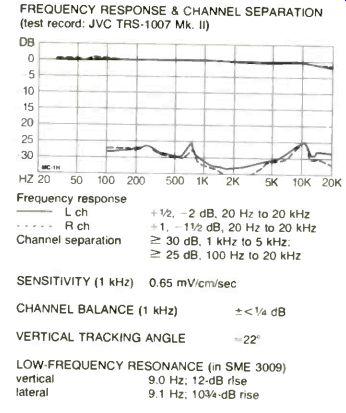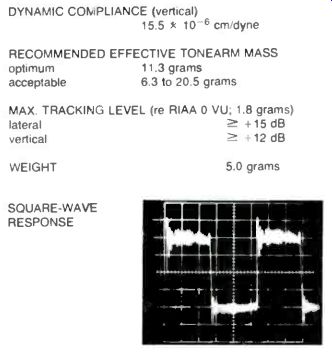
Boston Acoustics' Premier Pickup
Boston Acoustics MC-1vdH moving-coil phono pickup, with multi-radial (van den Hul) diamond stylus.
Price: $200. Warranty: "limited," one year parts and labor.
Manufacturer: made in Japan for Boston Acoustics, Inc.. 130 Condor Street, Boston, Mass. 02128.

FREQUENCY RESPONSE 8 CHANNEL SEPARATION (test record: JVC TRS-1007
Mk. II)
WE'VE SEEN A FEW cartridge manufacturers get into the loudspeaker business, but this is probably the first time we can remember seeing a speaker company turn around and bring out a cartridge. Actually, Boston Acoustics has two new pickups: the MC 1vdH reviewed here, which has a state-of the-art van den Hul stylus, and the less expensive ($140) MC-1E, which is identical except for the use of a conventional elliptical tip. The company's rationale for introducing these products is twofold and characteristically practical. One is the truism that the phono pickup you use affects your system's sound more than any other component except the speakers. The other is that most high-quality cartridges make it difficult, if not impossible, for typical users to obtain from them the performance they were designed to provide.
For example, most fixed-coil pickups (those falling into the moving-magnet, moving-iron, and other similar categories) require a load of approximately 47,000 ohms in parallel with some amount of capacitance (usually between 100 and 500 picofarads, depending on the particular model) to deliver their flattest frequency response. This loading is supplied by the phono input of your amplifier or receiver together with your turntable's tonearm wiring and cables. Most phono stages now provide the required 47k-ohm resistive load, but capacitance varies all over the lot, both in amplifiers and in turntables. And a capacitance mismatch of as little as 20% (not hard to come by) can cause a high frequency response error of several decibels with some pickups.
The other problem with fixed-coil cartridges is that their stylus-cantilever suspensions are often so compliant (for good low frequency tracking) that installation in a typical tonearm of medium to high effective mass yields an arm/cartridge resonance frequency below 8 Hz. This degrades warp tracking and increases the likelihood of amplifier overload or excessive low-frequency distortion from large, unwanted infrasonic signals.
Moving-coil cartridges, on the other hand, have very low output impedances and are therefore relatively insensitive to loading: You'll get the same response no matter what you plug them into. And they usually have relatively low compliances, as well (though this advantage is sometimes offset by increased weight), making them more compatible with the tonearms most people use. Unfortunately, most moving-coils are also very low-output devices, which makes it necessary for you to use some kind of step-up transformer or pre-preamp and increases their susceptibility to hum. Another common difficulty with moving-coil pickups (though less so than in the past) is a tendency to peakiness at the high end, sometimes accompanied by mediocre tracking ability.
With the MC-1vdH, Boston Acoustics seems to have retained all the genre's traditional strengths without any of the customary weaknesses. Sensitivity, for example, is quite high for a moving-coil, ensuring more than enough output for a good signal to-noise ratio with conventional phono preamps and eliminating the need for any auxiliary step-up device. And tracking ability is generally excellent, if not the very best Diversified Science Laboratories has measured. Distortion is very low for a cartridge, even at very high groove velocities, confirming the fine tracking ability and per haps also reflecting the groove-tracing performance of the van den Hul stylus.
Channel balance is superlative-essentially perfect-as is vertical tracking angle, which is almost smack on the 20-degree DIN standard.
Frequency response is exceptionally smooth and flat, with just a hint of a rolloff at the very top and certainly no peakiness.
Channel separation is unusually wide and uniform, exhibiting none of the deterioration at high frequencies one finds on many other cartridges. And square-wave response is very good, showing a mild over shoot accompanied by some low-level ringing (most of which is present in the test record).
As claimed by Boston Acoustics, the MC-1vdH's low mass and moderate compliance make it suitable for use in just about any tonearm you are likely to come across.
The cartridge is packaged with mounting hardware and an alignment protractor, which together with the unit's rather blocky shape makes accurate installation easier than usual. Boston Acoustics is also supplying its dealers with a more elaborate set-up gauge for even more accurate alignment of the cartridge in their customers' tone-arms.
As one would expect from the data, the MC-1vdH sounds extremely good very smooth and alive with a firm, stable stereo image and no hint of stridency, even on demanding material. We therefore have no hesitation in recommending it to quality-conscious buyers. The price, although not low, is in line with the going rate for premium cartridges, and if you are put off by it, you might reasonably look to the less costly MC-1E, which we expect is very nearly as good.

------
(High Fidelity, Jan. 1983)
Also see:
Dynavector DV-23R moving-coil phono cartridge (Equip. Report, Jan 1983)